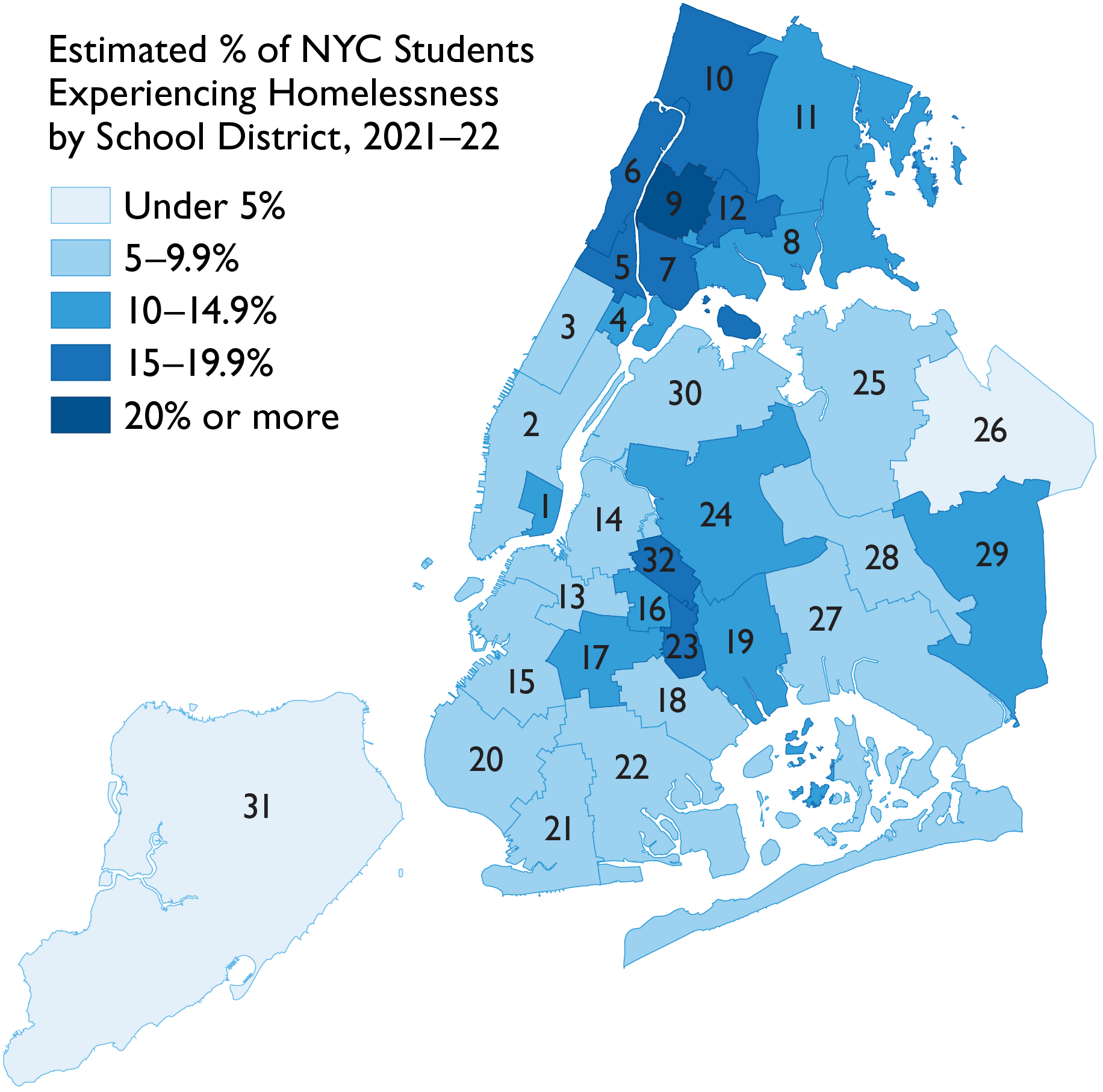Student Homelessness in New York City, 2021–22
The 2021–22 school year marked the seventh consecutive year in which more than 100,000 New York City public school students experienced homelessness.

The 2021-2022 school year marked the seventh consecutive year in which more than 100,000 New York City public school students experienced homelessness, a crisis which has now persisted through two Mayoral administrations and four schools Chancellors. Even as total enrollment in City schools fell last year, the number of students identified as homeless increased by 3.3%, rising from 101,000 to 104,000.
Data released by Advocates for Children of New York show that, of these 104,000 students, more than 29,000 spent time living in City shelters; 69,000 were “doubled up,” or temporarily sharing the housing of others due to loss of housing or economic hardship; and nearly 5,500 were unsheltered, living in cars, parks, or abandoned buildings. While they attended district and charter schools across the five boroughs, students experiencing homelessness were especially concentrated in the Bronx, upper Manhattan, and Brooklyn districts 23 (Brownsville) and 32 (Bushwick). In district 9 in the southwest Bronx, more than one in five students experienced homelessness last year—the highest rate in the city—and one in every 13 spent time in shelter.

In recent months, the total number of students in temporary housing has climbed even higher as an increasing number of families seeking asylum—many of whom have school-age children—have arrived in New York City and entered the shelter system.
“If these 100,000 children made up their own school district, it would be a district larger than 99.5% of all other districts nationwide. While the City works to address the underlying issue of homelessness, we also must ensure that students who are homeless get to class every day and receive the targeted supports they need to succeed in school.”
Kim Sweet, executive director of Advocates for Children of New York
High rates of chronic absenteeism and poor academic outcomes for students who are homeless—and especially for those living in shelter—are as disturbingly consistent as the prevalence of student homelessness itself. In 2020-21, students in shelter dropped out of high school at more than three times the rate of their permanently housed peers; only 60% graduated in four years; and 64% were chronically absent, meaning they missed at least one out of every ten school days.
The City has committed to hiring 100 shelter-based DOE Community Coordinators this year to help families navigate the school system, resolve barriers to regular attendance, and connect students in shelter with needed supports. However, a month and a half into the school year, at a time when the shelter system is at a breaking point, none of these staff have been hired, and there is a leadership vacuum at the DOE Office of Students in Temporary Housing following the departure of its executive director and other key staff. The City should fill these vacancies right away. And since the DOE can’t do this work alone, the City should also bring together City agencies to tackle the multitude of educational issues facing the growing number of students who are homeless, including transportation, chronic absenteeism, and delays in enrollment and service provision.
“The DOE needs to ensure the new migrant students entering the shelter system are enrolled in schools that can meet their needs, while not losing sight of the longstanding issues facing the tens of thousands of students who were already homeless,” said Jennifer Pringle, Director of AFC’s Learners in Temporary Housing Project. “The new Community Coordinators will be critical for helping students in shelter access a quality education and break the cycle of homelessness. Hiring and training all 100 of these staffers so they can support families on day one, along with filling the open leadership roles within the Students in Temporary Housing team, must be an urgent priority for this administration.”
-
View the press release as a PDF
October 26, 2022
Media Coverage
-
More Than 104,000 New York City Students Were Homeless Last Year
-
NYC’s homeless student population increased last school year despite enrollment drop: data
-
NYC sees spike in number of homeless public school students
-
Nearly 10% of NYC students were homeless last year, according to report


